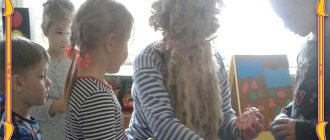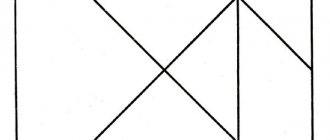How does cognitive interest arise in preschoolers?
Cognitive interest is not formed out of nowhere or at the will of parents. It appears when a child encounters something completely new that does not fit into the “matrix” of his knowledge and experience. Surprise and puzzlement appear. The riddle haunts the preschooler until he clears up the keys to the answer.
Example. Deniska, 3.5 years old, saw a small tractor with a body in front. The first thing the kid asked was: “Why is the tractor driving backwards?” After listening to the answer, he walked a few steps backwards, just in case. Then came the conclusion: “So the driver sees that he is lucky.”
The child saw a flower bloom on the windowsill, and he is ready to water the indoor plants every day to repeat the phenomenon. He watches his grandmother knead the dough, and he certainly wants to practice turning loose flour into plastic dough.
The preschooler wants to join activities that awaken emotions and experiences. Even putting together puzzles and construction sets gets the child interested in the fact that the result should be a beautiful picture or model.
Some objects and phenomena captivate the child for a short time, others hold attention for a long time. The main forms of expression of interest can be identified:
- Curiosity is a primary interest in a subject, object or event.
- Curiosity is the desire to study a subject in more detail, to find its still hidden properties. At this stage, the joy of learning new things is formed. Research is carried out using trial methods or questions.
- Direct cognitive interest is characterized by the emergence of a task or situation in which the child seeks to understand independently, to understand the true essence of the phenomenon. At this stage, the mechanisms are dismantled into individual screws or the doll is disassembled into its components to find out what’s inside.
Among the many problems of our time, the problem of developing cognitive interest in children in preschool age, which is an important period in a person’s life, remains especially relevant. Since at this age the foundations of the future personality are laid, the prerequisites for the mental, moral and physical development of the child are formed. In order for training and upbringing to contribute to the development of personality, it is necessary to “awaken” the cognitive need in the child, which is the source of his cognitive activity and underlies the development of a person’s cognitive interest. “Children's experimentation” helps to develop a positive attitude towards understanding the surrounding reality, which contributes to the formation of cognitive activity. In this case, it is necessary to rely on solving cognitive problems. A cognitive task can be given to children in three main forms: role-playing game; designation of situations by various symbolic means; problematic situations, puzzle situations and actual tasks. In the process of experimentation, children put forward a hypothesis and, with the help of search actions and experiments, prove the correctness of their assumption. Through elementary experiments and search actions, children acquire new knowledge about a particular object, influence the object in order to understand it, and identify hidden signs and properties. Thus, experimentation is aimed at cognitive results and helps to increase the cognitive activity of preschoolers.
A high level of cognitive activity of the child is ensured by gaming activities. Games provide children with natural exercises for the development of the mind, feelings and will, along with strengthening physical strength, promote the vital activity of the whole organism, develop inclinations, tastes, cultivate emotions, discipline, and develop independence. The game is “a serious school for children’s developing thinking.” The game closely interacts with the learning process. The content of games should be aimed at familiarizing children with objects, facts, and phenomena of the surrounding life, as well as at achieving the tasks of intellectual development: at forming methods of mental activity, developing children’s cognitive interests and abilities. In addition, the play activity of children creates a favorable emotional background for any activity. Thus, through the games “On the contrary”, “Good-bad”, children determine the positive and negative qualities of an object and name the opposite properties. These games can be used to discuss the actions and characters of the characters. At the same time, it is discussed what they (the children) would do in the place of the characters in a given situation. Children take part in such games with pleasure. Their reasoning during the activity helps to maintain interest in already familiar characters from famous fairy tales and stories, children’s speech expressions develop, and their activity during the discussion increases.
The child’s visual activities include drawing, modeling, and making appliqués. Classes are useful at any age, since children are often attracted by the process itself, rather than the result. It doesn’t matter that the baby only produces chaotic lines and circles. In these inept actions, the hand and technique of drawing movements, visual perception are developed, and a sense of color and harmonious color combinations is formed. Making appliqués gives the child his first ideas about symmetry. Symmetry becomes a discovery for a preschooler when snowflakes, leaves and other elements of an applicative plot are cut out of a folded sheet of paper.
After this practice, children develop the ability to see symmetry in the world around them.
The cognitive activity of a preschooler contributes to the development of mental activity and thinking. Such activity can manifest itself in practical and mental forms. In the case when a child carries out simple experiments, cognitive research activity takes place. A preschooler does not engage in experimentation for fun. He encounters a previously unknown property of an object and strives to understand this property and discover the argumentation. The child checks how a paper boat floats and what happens when the paper is completely saturated with water. Experiments with what can be thrown higher - a ball or a balloon.
Labor activity. A necessary and important condition for the development of the cognitive interest of a preschool child is the joint partnership of an adult and a child. A preschooler wants to be like mom or dad. He watches what adults do and wants to try his hand at it too. At this time, the child is driven by a strong interest and desire to be on an equal footing.
Increasing the effectiveness of developmental interaction between children and adults is facilitated by creating a friendly atmosphere and creating a situation of success for each participant in joint activities. The content of each joint interaction between children and adults should contain something new, include feasible and specific tasks, the solution of which requires active work of thought, the ability to combine the existing stock of accumulated experience with direct sensory ideas about the observed object or phenomenon of the surrounding life.
The child is fascinated by the process, not the result. He wants to knead the dough with his mother and water the flowers in the flowerbed next to his father. The preschooler declares that he will help. Being involved in a useful cause is important. In an effort to fully develop a child, adults need to remember that all types of children’s activities bring them benefit. It is important for a preschooler to play and draw, design and perform feasible household chores. Parents should provide the child with the opportunity to exercise independence, be patient with children’s experimentation, and actively participate in joint activities.
Author: Anna Pechnikova.
What maintains cognitive interest in preschool age
Cognitive interest can easily fade away if it is not nourished. Adults play a certain role here, encouraging the child to continue, but the main factors that stimulate continuation are cognitive independence and the presence of motivation.
In the process of learning something new, there is a combination of feelings and the intellectual component. A preschooler feels a sense of admiration when he learns that the seasons in the southern hemisphere follow different principles.
The joy of learning new things causes impatience and complete fascination with a toy or book that contains new information. Dismantling an alarm clock or kitchen appliances provokes such excitement that the young explorer may not notice his parents watching him.
Small experiments that can be carried out with the help of numerous sets of young physicists and chemists make you freeze in anticipation of the result. And finally, nothing motivates you to continue learning more than a solution achieved on your own.
Cognitive independence
Starting from the age of five, a preschooler increasingly asks chains of clarifying questions. He becomes interested in a specific subject or process, asks the main question that worries him, but the answer he receives prompts him to further research and new questions.
The essence of cognitive independence lies in the fact that the child himself, without additional incentives, feels ready to acquire new knowledge.
Older preschoolers can express their disagreement with the answer, offer their own version and persistently find out where their assumption is wrong. If it is necessary to obtain additional information, preschoolers themselves initiate a conversation with an adult and ask questions, filling in gaps in their knowledge.
One of the main conditions for the manifestation of cognitive independence is the sufficient development of the volitional sphere. When solving a task set for yourself, you need to finish the job, even if you encounter obstacles: screws don’t unscrew, parts don’t fit together, you can’t draw as your imagination suggests.
Cognitive motivation
Motivation is the second pillar on which cognitive interest stands. An adult’s verbal offer to assemble a model or read a book is not valid. It is necessary that the child is passionate about the process himself and strives to continue or begin the study.
The formation of cognitive motivation in preschool children is closely related to the development of voluntary attention.
A task that previously intrigued a child may turn out to be quite difficult for him. To continue to solve it, you need to maintain attention and remember the goal. This is beyond the power of younger preschoolers who have not yet learned to manage their attention.
Psychologists identify the conditions necessary for the formation of cognitive motivation of a preschooler:
- Emotional support. A child retains attention and interest in a task longer if he is encouraged, praised, and supported.
- Activation of thought processes. Minor hints for the child, an offer to check another version, inspires the young researcher. He comes up with an immediate goal and ideas on how to achieve it.
- Discussing successes and failures, encouraging the child to independently find explanations for why it was or was not possible to find a solution.
Cultivating curiosity gives rise to the independent habit of looking for everything unknown and incomprehensible in the surrounding space. Learning new things becomes a need for a child and motivates him to take cognitive actions, be it learning to read or compiling a collection.
Bibliography
- Ivanenko S.F., Formation of speech perception in children with severe speech impairment. M., 2004.
- Markova L.S. Organization of correctional and developmental education for preschoolers with mental retardation. Practical guide. – M, 2005
- Federal State Educational Standard for Preschool Education, 2013.
- Khudenko E.D., Melnikova T.S., Shakhovskaya S.N. How to teach a child to think and speak? // NPF "Uniserv". – M.: 1993. – 172 p.
- Shevchenko S.G. Preparing children with mental retardation for school. Book 1 / Generally ed. S.G. Shevchenko. – M.: School Press, 2003. – 96 p.
Development of cognitive interests in older preschoolers
In older preschool age, the relationship between cognitive interest and attention increases significantly. During this period, children realize that the correct result largely depends on how carefully all the details were taken into account.
The arbitrariness of the attention function is also formed; children are able to concentrate on a task without being distracted by foreign objects or situations.
The progressive development of cognitive processes leads to the fact that older children analyze more, learn to highlight the main thing and abstract from unimportant signs. On the one hand, they are more capable of finding answers to their questions, but, on the other hand, their cognitive interests cover more areas.
At this stage, a cognitive interest in mathematics is formed. Preschoolers are interested in performing simple arithmetic operations, measuring objects, and solving logic problems.
Search and experimental activities play a significant role in the development of cognitive activity. The child is an experimenter. Understanding the world through experience is its natural state. In addition, the result obtained as part of the experiment is assimilated much better than just an adult’s story.
During the experiment, the older preschooler, on his own, receives answers to questions that are significant at his age: “How?” and why?". You can tell your child all you want about the laws of aerodynamics, but he won’t understand what you’re talking about until he flies a kite.
On walks or excursions, children get the opportunity to constantly experiment: why a leaf floats down a stream, why snow melts; see that the plucked branch will dry out or, conversely, take root in a glass of water.
In essence, cognitive research activities are close to experiments. It involves experimentation, but also uses collecting to teach how to classify objects according to various characteristics. You can collect herbariums and stamps, as well as figurines from the robot collection.
Excursions help you explore a piece of space along which the route is laid. Educational activities consist of acquiring minimal cartography skills, studying the plants and habits of animals encountered along the way.
The role of an adult in the formation of cognitive interest of preschool children
The main task of adults at the stage of formation of cognitive interest is to maintain the motivation of a preschooler and use methods that help keep children’s attention and complete the task.
Parents need to make sure not only that there are reference books and encyclopedias suitable for preschool age in the house, but also regularly read with their child materials that enrich the child’s knowledge. It is useful to use non-standard developmental methods. For example, finger games for children are exciting in their practical implementation and bring tangible benefits to the development of fine motor skills.
The main lines of work in the development of children's cognitive interest:
- Supporting the child's desire to ask questions. Expressed in a favorable attitude and detailed explanation instead of short answers and excuses.
- Additional stimulation of cognitive interest. It consists of exciting stories, identifying topics that interest the preschooler, expanding answers, going beyond the topic. For example, when talking about hours and minutes, you can touch on the calendar.
- Application of games. For preschoolers, this is the main activity in which new skills are learned. You can build games in the form of “question-answer” or correct information that the child uses incorrectly when playing with peers.
- Supporting a preschooler in his research. Praise upon achievement of a result and during the activity so that the child understands that his efforts aimed at solving the problem are important.
- Help in mastering planning and goal setting skills.
Adult support for a child's curiosity in relation to any area of life will lead to the presence of developed cognitive interest. And this is a good deposit for upcoming school success and diversified personality development at any age stage.






